English Language and Linguistics: Analysis of Cox and Hill and Oshima and Hogue Books for EAP Education
VerifiedAdded on 2023/06/03
|13
|3527
|422
AI Summary
The report provides a detailed analysis of two different books, their audience, academic discourse, treatment of features, and recommendations for English for Academic Purposes (EAP) education.
Contribute Materials
Your contribution can guide someone’s learning journey. Share your
documents today.
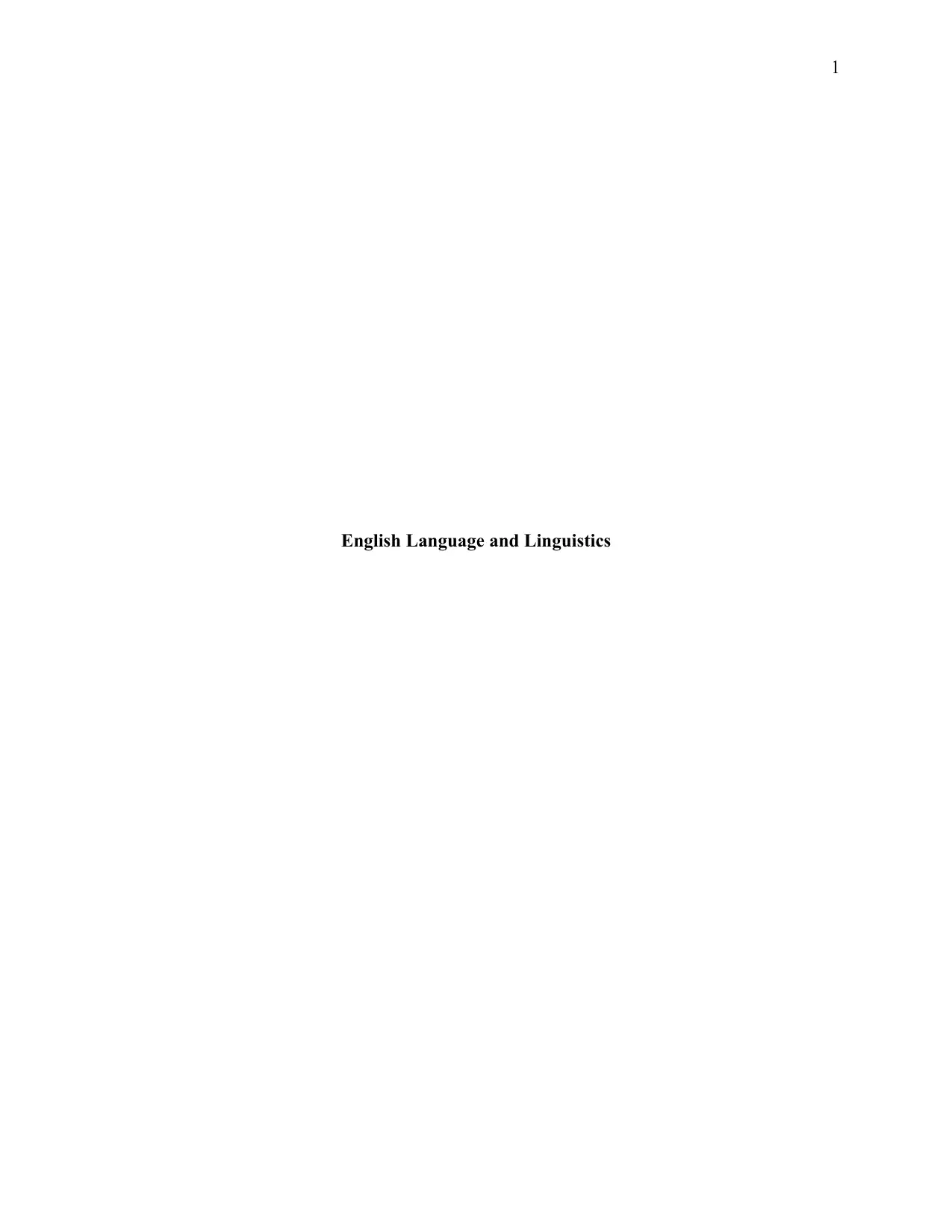
1
English Language and Linguistics
English Language and Linguistics
Secure Best Marks with AI Grader
Need help grading? Try our AI Grader for instant feedback on your assignments.
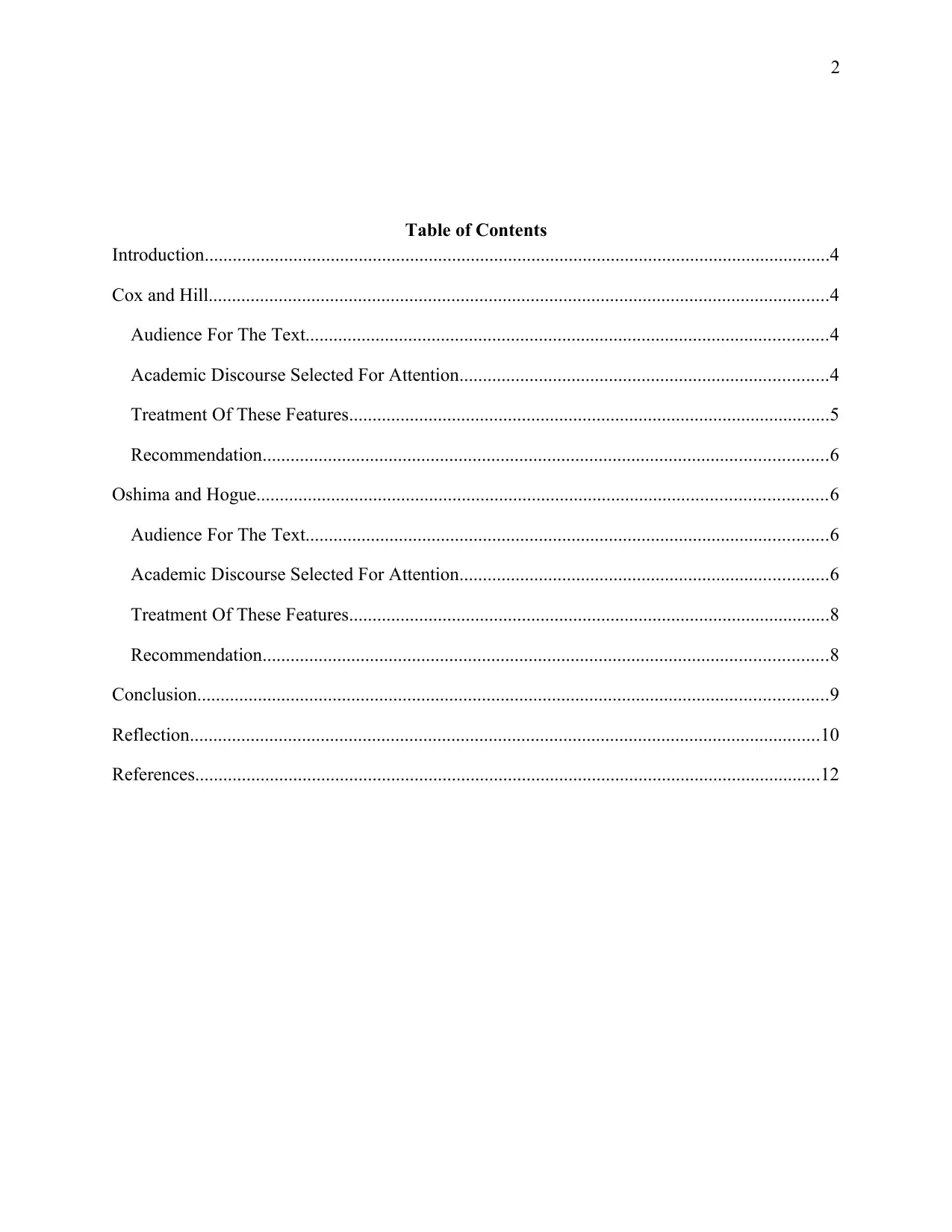
2
Table of Contents
Introduction......................................................................................................................................4
Cox and Hill.....................................................................................................................................4
Audience For The Text................................................................................................................4
Academic Discourse Selected For Attention...............................................................................4
Treatment Of These Features.......................................................................................................5
Recommendation.........................................................................................................................6
Oshima and Hogue..........................................................................................................................6
Audience For The Text................................................................................................................6
Academic Discourse Selected For Attention...............................................................................6
Treatment Of These Features.......................................................................................................8
Recommendation.........................................................................................................................8
Conclusion.......................................................................................................................................9
Reflection.......................................................................................................................................10
References......................................................................................................................................12
Table of Contents
Introduction......................................................................................................................................4
Cox and Hill.....................................................................................................................................4
Audience For The Text................................................................................................................4
Academic Discourse Selected For Attention...............................................................................4
Treatment Of These Features.......................................................................................................5
Recommendation.........................................................................................................................6
Oshima and Hogue..........................................................................................................................6
Audience For The Text................................................................................................................6
Academic Discourse Selected For Attention...............................................................................6
Treatment Of These Features.......................................................................................................8
Recommendation.........................................................................................................................8
Conclusion.......................................................................................................................................9
Reflection.......................................................................................................................................10
References......................................................................................................................................12

3
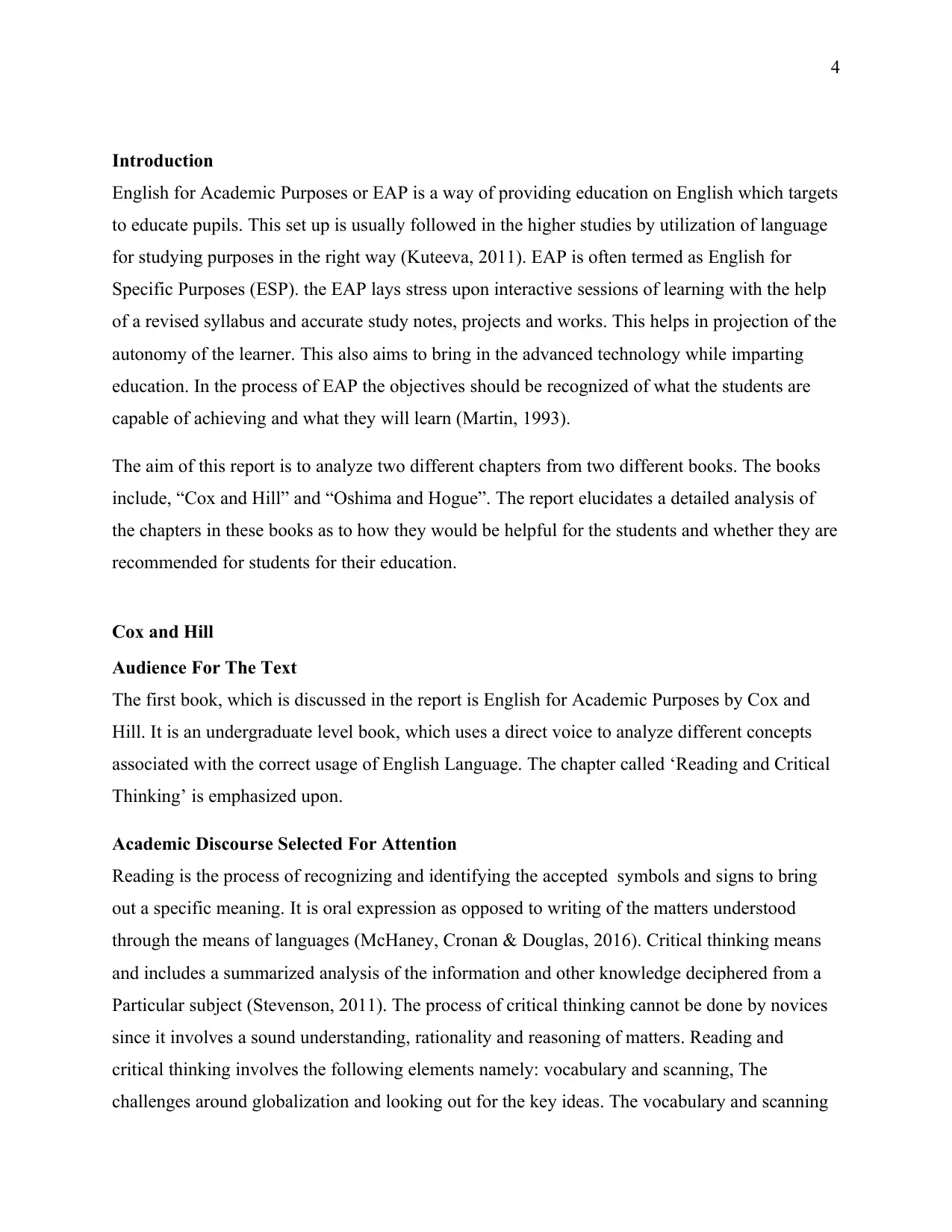
4
Introduction
English for Academic Purposes or EAP is a way of providing education on English which targets
to educate pupils. This set up is usually followed in the higher studies by utilization of language
for studying purposes in the right way (Kuteeva, 2011). EAP is often termed as English for
Specific Purposes (ESP). the EAP lays stress upon interactive sessions of learning with the help
of a revised syllabus and accurate study notes, projects and works. This helps in projection of the
autonomy of the learner. This also aims to bring in the advanced technology while imparting
education. In the process of EAP the objectives should be recognized of what the students are
capable of achieving and what they will learn (Martin, 1993).
The aim of this report is to analyze two different chapters from two different books. The books
include, “Cox and Hill” and “Oshima and Hogue”. The report elucidates a detailed analysis of
the chapters in these books as to how they would be helpful for the students and whether they are
recommended for students for their education.
Cox and Hill
Audience For The Text
The first book, which is discussed in the report is English for Academic Purposes by Cox and
Hill. It is an undergraduate level book, which uses a direct voice to analyze different concepts
associated with the correct usage of English Language. The chapter called ‘Reading and Critical
Thinking’ is emphasized upon.
Academic Discourse Selected For Attention
Reading is the process of recognizing and identifying the accepted symbols and signs to bring
out a specific meaning. It is oral expression as opposed to writing of the matters understood
through the means of languages (McHaney, Cronan & Douglas, 2016). Critical thinking means
and includes a summarized analysis of the information and other knowledge deciphered from a
Particular subject (Stevenson, 2011). The process of critical thinking cannot be done by novices
since it involves a sound understanding, rationality and reasoning of matters. Reading and
critical thinking involves the following elements namely: vocabulary and scanning, The
challenges around globalization and looking out for the key ideas. The vocabulary and scanning
Introduction
English for Academic Purposes or EAP is a way of providing education on English which targets
to educate pupils. This set up is usually followed in the higher studies by utilization of language
for studying purposes in the right way (Kuteeva, 2011). EAP is often termed as English for
Specific Purposes (ESP). the EAP lays stress upon interactive sessions of learning with the help
of a revised syllabus and accurate study notes, projects and works. This helps in projection of the
autonomy of the learner. This also aims to bring in the advanced technology while imparting
education. In the process of EAP the objectives should be recognized of what the students are
capable of achieving and what they will learn (Martin, 1993).
The aim of this report is to analyze two different chapters from two different books. The books
include, “Cox and Hill” and “Oshima and Hogue”. The report elucidates a detailed analysis of
the chapters in these books as to how they would be helpful for the students and whether they are
recommended for students for their education.
Cox and Hill
Audience For The Text
The first book, which is discussed in the report is English for Academic Purposes by Cox and
Hill. It is an undergraduate level book, which uses a direct voice to analyze different concepts
associated with the correct usage of English Language. The chapter called ‘Reading and Critical
Thinking’ is emphasized upon.
Academic Discourse Selected For Attention
Reading is the process of recognizing and identifying the accepted symbols and signs to bring
out a specific meaning. It is oral expression as opposed to writing of the matters understood
through the means of languages (McHaney, Cronan & Douglas, 2016). Critical thinking means
and includes a summarized analysis of the information and other knowledge deciphered from a
Particular subject (Stevenson, 2011). The process of critical thinking cannot be done by novices
since it involves a sound understanding, rationality and reasoning of matters. Reading and
critical thinking involves the following elements namely: vocabulary and scanning, The
challenges around globalization and looking out for the key ideas. The vocabulary and scanning
Secure Best Marks with AI Grader
Need help grading? Try our AI Grader for instant feedback on your assignments.
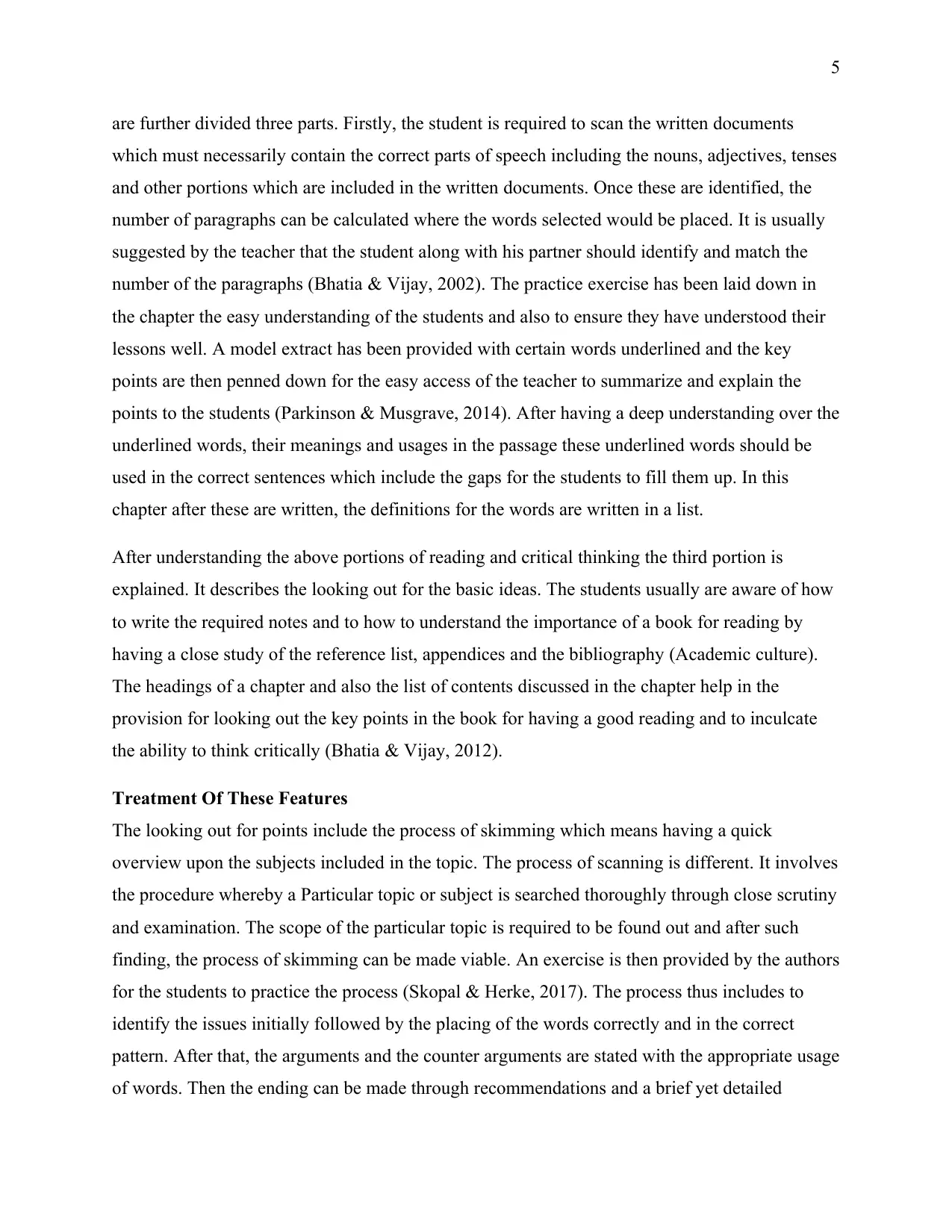
5
are further divided three parts. Firstly, the student is required to scan the written documents
which must necessarily contain the correct parts of speech including the nouns, adjectives, tenses
and other portions which are included in the written documents. Once these are identified, the
number of paragraphs can be calculated where the words selected would be placed. It is usually
suggested by the teacher that the student along with his partner should identify and match the
number of the paragraphs (Bhatia & Vijay, 2002). The practice exercise has been laid down in
the chapter the easy understanding of the students and also to ensure they have understood their
lessons well. A model extract has been provided with certain words underlined and the key
points are then penned down for the easy access of the teacher to summarize and explain the
points to the students (Parkinson & Musgrave, 2014). After having a deep understanding over the
underlined words, their meanings and usages in the passage these underlined words should be
used in the correct sentences which include the gaps for the students to fill them up. In this
chapter after these are written, the definitions for the words are written in a list.
After understanding the above portions of reading and critical thinking the third portion is
explained. It describes the looking out for the basic ideas. The students usually are aware of how
to write the required notes and to how to understand the importance of a book for reading by
having a close study of the reference list, appendices and the bibliography (Academic culture).
The headings of a chapter and also the list of contents discussed in the chapter help in the
provision for looking out the key points in the book for having a good reading and to inculcate
the ability to think critically (Bhatia & Vijay, 2012).
Treatment Of These Features
The looking out for points include the process of skimming which means having a quick
overview upon the subjects included in the topic. The process of scanning is different. It involves
the procedure whereby a Particular topic or subject is searched thoroughly through close scrutiny
and examination. The scope of the particular topic is required to be found out and after such
finding, the process of skimming can be made viable. An exercise is then provided by the authors
for the students to practice the process (Skopal & Herke, 2017). The process thus includes to
identify the issues initially followed by the placing of the words correctly and in the correct
pattern. After that, the arguments and the counter arguments are stated with the appropriate usage
of words. Then the ending can be made through recommendations and a brief yet detailed
are further divided three parts. Firstly, the student is required to scan the written documents
which must necessarily contain the correct parts of speech including the nouns, adjectives, tenses
and other portions which are included in the written documents. Once these are identified, the
number of paragraphs can be calculated where the words selected would be placed. It is usually
suggested by the teacher that the student along with his partner should identify and match the
number of the paragraphs (Bhatia & Vijay, 2002). The practice exercise has been laid down in
the chapter the easy understanding of the students and also to ensure they have understood their
lessons well. A model extract has been provided with certain words underlined and the key
points are then penned down for the easy access of the teacher to summarize and explain the
points to the students (Parkinson & Musgrave, 2014). After having a deep understanding over the
underlined words, their meanings and usages in the passage these underlined words should be
used in the correct sentences which include the gaps for the students to fill them up. In this
chapter after these are written, the definitions for the words are written in a list.
After understanding the above portions of reading and critical thinking the third portion is
explained. It describes the looking out for the basic ideas. The students usually are aware of how
to write the required notes and to how to understand the importance of a book for reading by
having a close study of the reference list, appendices and the bibliography (Academic culture).
The headings of a chapter and also the list of contents discussed in the chapter help in the
provision for looking out the key points in the book for having a good reading and to inculcate
the ability to think critically (Bhatia & Vijay, 2012).
Treatment Of These Features
The looking out for points include the process of skimming which means having a quick
overview upon the subjects included in the topic. The process of scanning is different. It involves
the procedure whereby a Particular topic or subject is searched thoroughly through close scrutiny
and examination. The scope of the particular topic is required to be found out and after such
finding, the process of skimming can be made viable. An exercise is then provided by the authors
for the students to practice the process (Skopal & Herke, 2017). The process thus includes to
identify the issues initially followed by the placing of the words correctly and in the correct
pattern. After that, the arguments and the counter arguments are stated with the appropriate usage
of words. Then the ending can be made through recommendations and a brief yet detailed
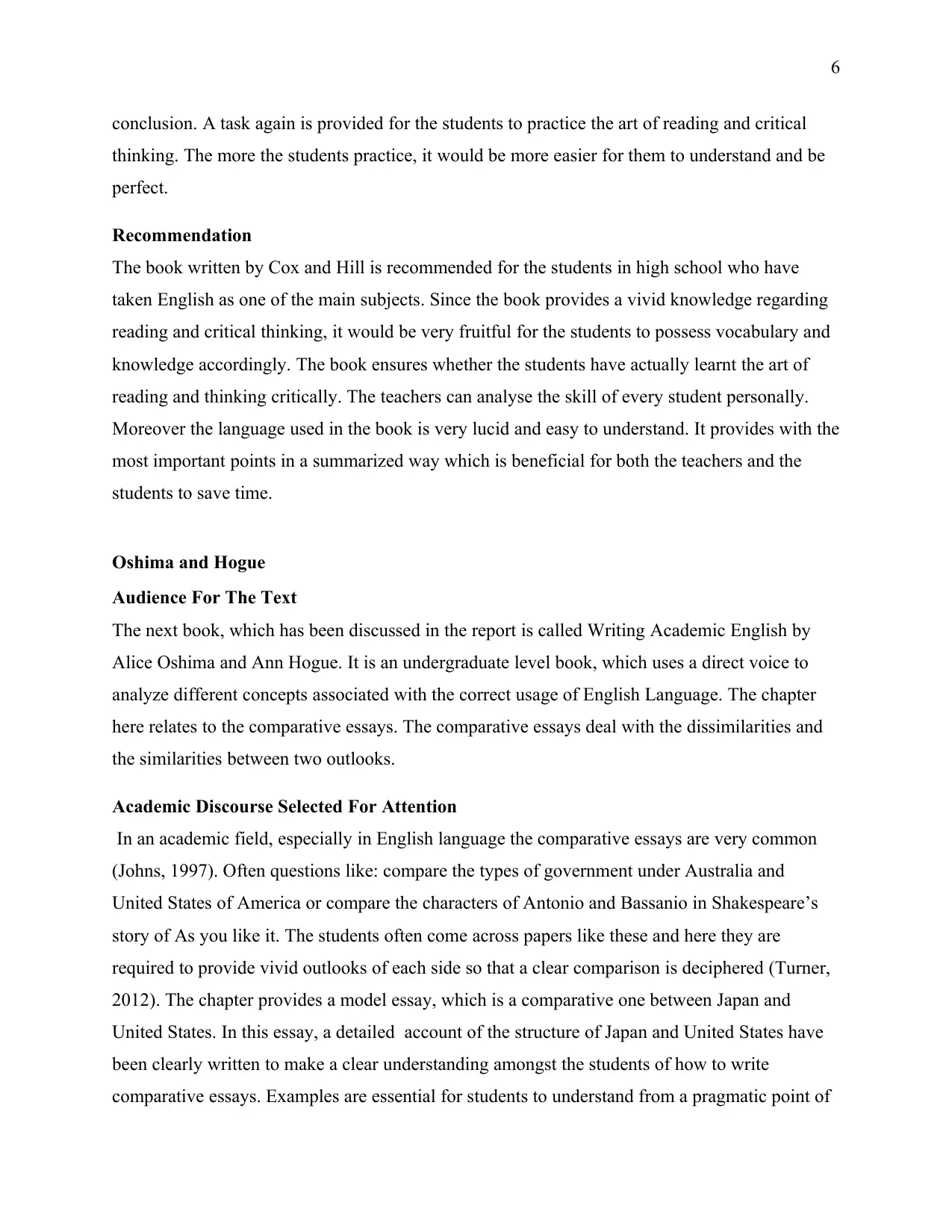
6
conclusion. A task again is provided for the students to practice the art of reading and critical
thinking. The more the students practice, it would be more easier for them to understand and be
perfect.
Recommendation
The book written by Cox and Hill is recommended for the students in high school who have
taken English as one of the main subjects. Since the book provides a vivid knowledge regarding
reading and critical thinking, it would be very fruitful for the students to possess vocabulary and
knowledge accordingly. The book ensures whether the students have actually learnt the art of
reading and thinking critically. The teachers can analyse the skill of every student personally.
Moreover the language used in the book is very lucid and easy to understand. It provides with the
most important points in a summarized way which is beneficial for both the teachers and the
students to save time.
Oshima and Hogue
Audience For The Text
The next book, which has been discussed in the report is called Writing Academic English by
Alice Oshima and Ann Hogue. It is an undergraduate level book, which uses a direct voice to
analyze different concepts associated with the correct usage of English Language. The chapter
here relates to the comparative essays. The comparative essays deal with the dissimilarities and
the similarities between two outlooks.
Academic Discourse Selected For Attention
In an academic field, especially in English language the comparative essays are very common
(Johns, 1997). Often questions like: compare the types of government under Australia and
United States of America or compare the characters of Antonio and Bassanio in Shakespeare’s
story of As you like it. The students often come across papers like these and here they are
required to provide vivid outlooks of each side so that a clear comparison is deciphered (Turner,
2012). The chapter provides a model essay, which is a comparative one between Japan and
United States. In this essay, a detailed account of the structure of Japan and United States have
been clearly written to make a clear understanding amongst the students of how to write
comparative essays. Examples are essential for students to understand from a pragmatic point of
conclusion. A task again is provided for the students to practice the art of reading and critical
thinking. The more the students practice, it would be more easier for them to understand and be
perfect.
Recommendation
The book written by Cox and Hill is recommended for the students in high school who have
taken English as one of the main subjects. Since the book provides a vivid knowledge regarding
reading and critical thinking, it would be very fruitful for the students to possess vocabulary and
knowledge accordingly. The book ensures whether the students have actually learnt the art of
reading and thinking critically. The teachers can analyse the skill of every student personally.
Moreover the language used in the book is very lucid and easy to understand. It provides with the
most important points in a summarized way which is beneficial for both the teachers and the
students to save time.
Oshima and Hogue
Audience For The Text
The next book, which has been discussed in the report is called Writing Academic English by
Alice Oshima and Ann Hogue. It is an undergraduate level book, which uses a direct voice to
analyze different concepts associated with the correct usage of English Language. The chapter
here relates to the comparative essays. The comparative essays deal with the dissimilarities and
the similarities between two outlooks.
Academic Discourse Selected For Attention
In an academic field, especially in English language the comparative essays are very common
(Johns, 1997). Often questions like: compare the types of government under Australia and
United States of America or compare the characters of Antonio and Bassanio in Shakespeare’s
story of As you like it. The students often come across papers like these and here they are
required to provide vivid outlooks of each side so that a clear comparison is deciphered (Turner,
2012). The chapter provides a model essay, which is a comparative one between Japan and
United States. In this essay, a detailed account of the structure of Japan and United States have
been clearly written to make a clear understanding amongst the students of how to write
comparative essays. Examples are essential for students to understand from a pragmatic point of
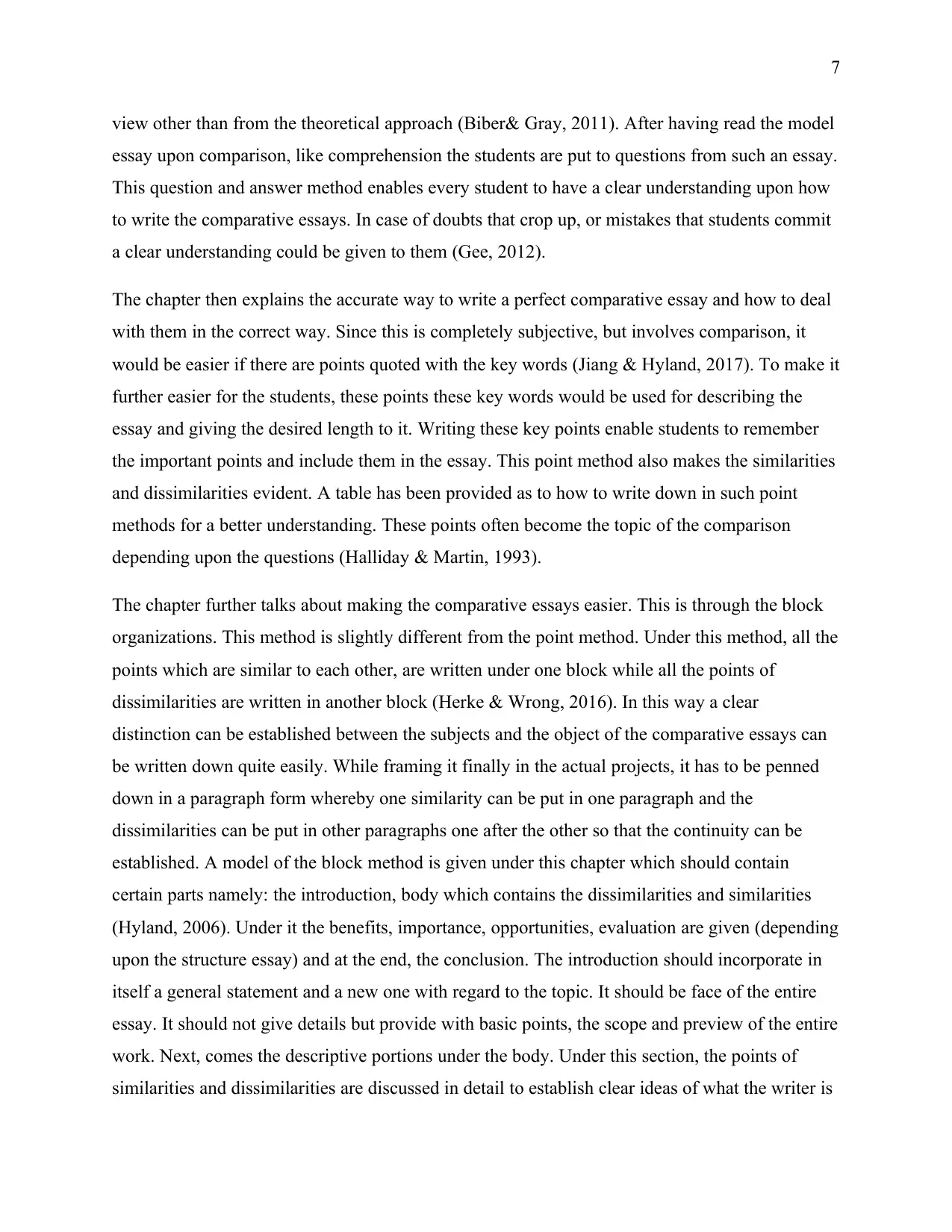
7
view other than from the theoretical approach (Biber& Gray, 2011). After having read the model
essay upon comparison, like comprehension the students are put to questions from such an essay.
This question and answer method enables every student to have a clear understanding upon how
to write the comparative essays. In case of doubts that crop up, or mistakes that students commit
a clear understanding could be given to them (Gee, 2012).
The chapter then explains the accurate way to write a perfect comparative essay and how to deal
with them in the correct way. Since this is completely subjective, but involves comparison, it
would be easier if there are points quoted with the key words (Jiang & Hyland, 2017). To make it
further easier for the students, these points these key words would be used for describing the
essay and giving the desired length to it. Writing these key points enable students to remember
the important points and include them in the essay. This point method also makes the similarities
and dissimilarities evident. A table has been provided as to how to write down in such point
methods for a better understanding. These points often become the topic of the comparison
depending upon the questions (Halliday & Martin, 1993).
The chapter further talks about making the comparative essays easier. This is through the block
organizations. This method is slightly different from the point method. Under this method, all the
points which are similar to each other, are written under one block while all the points of
dissimilarities are written in another block (Herke & Wrong, 2016). In this way a clear
distinction can be established between the subjects and the object of the comparative essays can
be written down quite easily. While framing it finally in the actual projects, it has to be penned
down in a paragraph form whereby one similarity can be put in one paragraph and the
dissimilarities can be put in other paragraphs one after the other so that the continuity can be
established. A model of the block method is given under this chapter which should contain
certain parts namely: the introduction, body which contains the dissimilarities and similarities
(Hyland, 2006). Under it the benefits, importance, opportunities, evaluation are given (depending
upon the structure essay) and at the end, the conclusion. The introduction should incorporate in
itself a general statement and a new one with regard to the topic. It should be face of the entire
essay. It should not give details but provide with basic points, the scope and preview of the entire
work. Next, comes the descriptive portions under the body. Under this section, the points of
similarities and dissimilarities are discussed in detail to establish clear ideas of what the writer is
view other than from the theoretical approach (Biber& Gray, 2011). After having read the model
essay upon comparison, like comprehension the students are put to questions from such an essay.
This question and answer method enables every student to have a clear understanding upon how
to write the comparative essays. In case of doubts that crop up, or mistakes that students commit
a clear understanding could be given to them (Gee, 2012).
The chapter then explains the accurate way to write a perfect comparative essay and how to deal
with them in the correct way. Since this is completely subjective, but involves comparison, it
would be easier if there are points quoted with the key words (Jiang & Hyland, 2017). To make it
further easier for the students, these points these key words would be used for describing the
essay and giving the desired length to it. Writing these key points enable students to remember
the important points and include them in the essay. This point method also makes the similarities
and dissimilarities evident. A table has been provided as to how to write down in such point
methods for a better understanding. These points often become the topic of the comparison
depending upon the questions (Halliday & Martin, 1993).
The chapter further talks about making the comparative essays easier. This is through the block
organizations. This method is slightly different from the point method. Under this method, all the
points which are similar to each other, are written under one block while all the points of
dissimilarities are written in another block (Herke & Wrong, 2016). In this way a clear
distinction can be established between the subjects and the object of the comparative essays can
be written down quite easily. While framing it finally in the actual projects, it has to be penned
down in a paragraph form whereby one similarity can be put in one paragraph and the
dissimilarities can be put in other paragraphs one after the other so that the continuity can be
established. A model of the block method is given under this chapter which should contain
certain parts namely: the introduction, body which contains the dissimilarities and similarities
(Hyland, 2006). Under it the benefits, importance, opportunities, evaluation are given (depending
upon the structure essay) and at the end, the conclusion. The introduction should incorporate in
itself a general statement and a new one with regard to the topic. It should be face of the entire
essay. It should not give details but provide with basic points, the scope and preview of the entire
work. Next, comes the descriptive portions under the body. Under this section, the points of
similarities and dissimilarities are discussed in detail to establish clear ideas of what the writer is
Paraphrase This Document
Need a fresh take? Get an instant paraphrase of this document with our AI Paraphraser
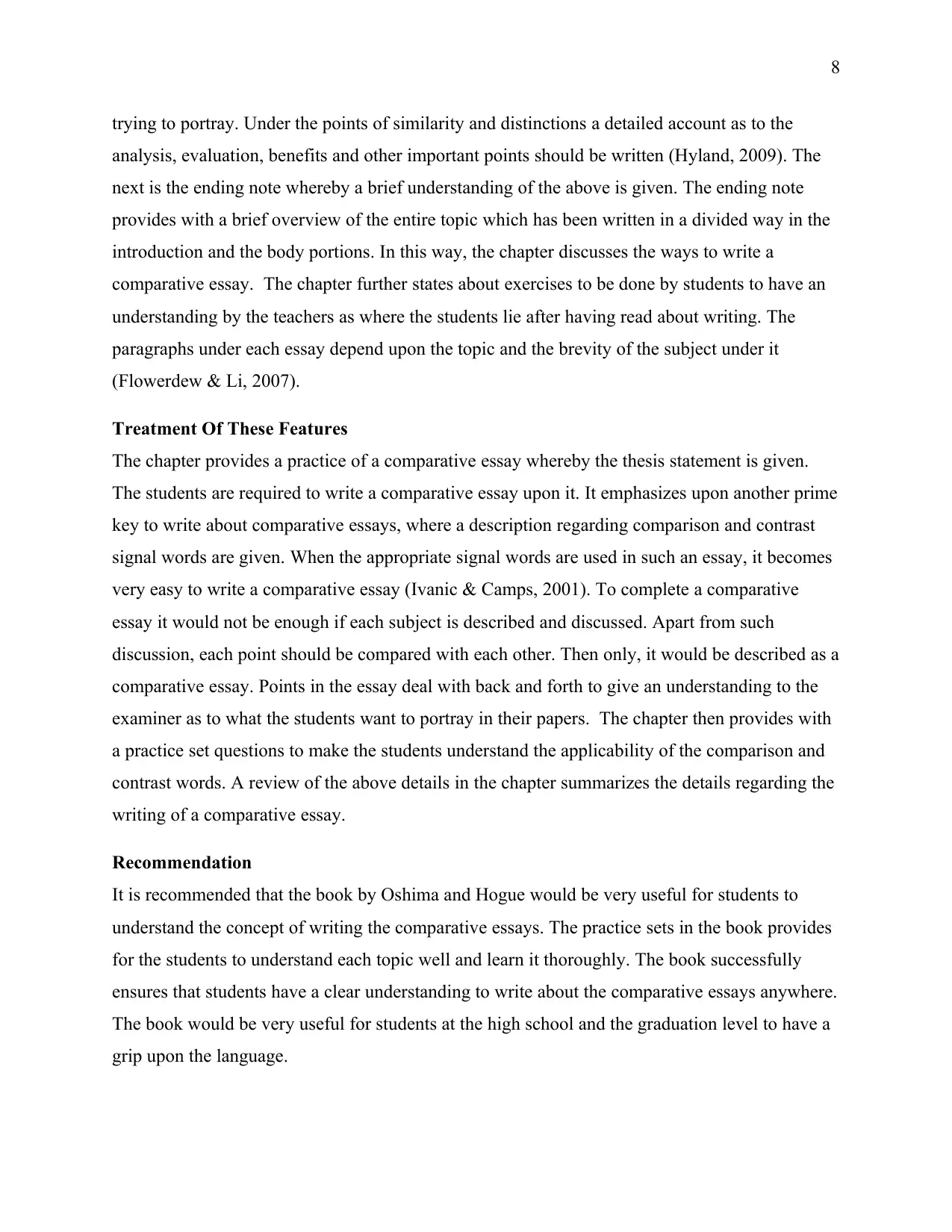
8
trying to portray. Under the points of similarity and distinctions a detailed account as to the
analysis, evaluation, benefits and other important points should be written (Hyland, 2009). The
next is the ending note whereby a brief understanding of the above is given. The ending note
provides with a brief overview of the entire topic which has been written in a divided way in the
introduction and the body portions. In this way, the chapter discusses the ways to write a
comparative essay. The chapter further states about exercises to be done by students to have an
understanding by the teachers as where the students lie after having read about writing. The
paragraphs under each essay depend upon the topic and the brevity of the subject under it
(Flowerdew & Li, 2007).
Treatment Of These Features
The chapter provides a practice of a comparative essay whereby the thesis statement is given.
The students are required to write a comparative essay upon it. It emphasizes upon another prime
key to write about comparative essays, where a description regarding comparison and contrast
signal words are given. When the appropriate signal words are used in such an essay, it becomes
very easy to write a comparative essay (Ivanic & Camps, 2001). To complete a comparative
essay it would not be enough if each subject is described and discussed. Apart from such
discussion, each point should be compared with each other. Then only, it would be described as a
comparative essay. Points in the essay deal with back and forth to give an understanding to the
examiner as to what the students want to portray in their papers. The chapter then provides with
a practice set questions to make the students understand the applicability of the comparison and
contrast words. A review of the above details in the chapter summarizes the details regarding the
writing of a comparative essay.
Recommendation
It is recommended that the book by Oshima and Hogue would be very useful for students to
understand the concept of writing the comparative essays. The practice sets in the book provides
for the students to understand each topic well and learn it thoroughly. The book successfully
ensures that students have a clear understanding to write about the comparative essays anywhere.
The book would be very useful for students at the high school and the graduation level to have a
grip upon the language.
trying to portray. Under the points of similarity and distinctions a detailed account as to the
analysis, evaluation, benefits and other important points should be written (Hyland, 2009). The
next is the ending note whereby a brief understanding of the above is given. The ending note
provides with a brief overview of the entire topic which has been written in a divided way in the
introduction and the body portions. In this way, the chapter discusses the ways to write a
comparative essay. The chapter further states about exercises to be done by students to have an
understanding by the teachers as where the students lie after having read about writing. The
paragraphs under each essay depend upon the topic and the brevity of the subject under it
(Flowerdew & Li, 2007).
Treatment Of These Features
The chapter provides a practice of a comparative essay whereby the thesis statement is given.
The students are required to write a comparative essay upon it. It emphasizes upon another prime
key to write about comparative essays, where a description regarding comparison and contrast
signal words are given. When the appropriate signal words are used in such an essay, it becomes
very easy to write a comparative essay (Ivanic & Camps, 2001). To complete a comparative
essay it would not be enough if each subject is described and discussed. Apart from such
discussion, each point should be compared with each other. Then only, it would be described as a
comparative essay. Points in the essay deal with back and forth to give an understanding to the
examiner as to what the students want to portray in their papers. The chapter then provides with
a practice set questions to make the students understand the applicability of the comparison and
contrast words. A review of the above details in the chapter summarizes the details regarding the
writing of a comparative essay.
Recommendation
It is recommended that the book by Oshima and Hogue would be very useful for students to
understand the concept of writing the comparative essays. The practice sets in the book provides
for the students to understand each topic well and learn it thoroughly. The book successfully
ensures that students have a clear understanding to write about the comparative essays anywhere.
The book would be very useful for students at the high school and the graduation level to have a
grip upon the language.
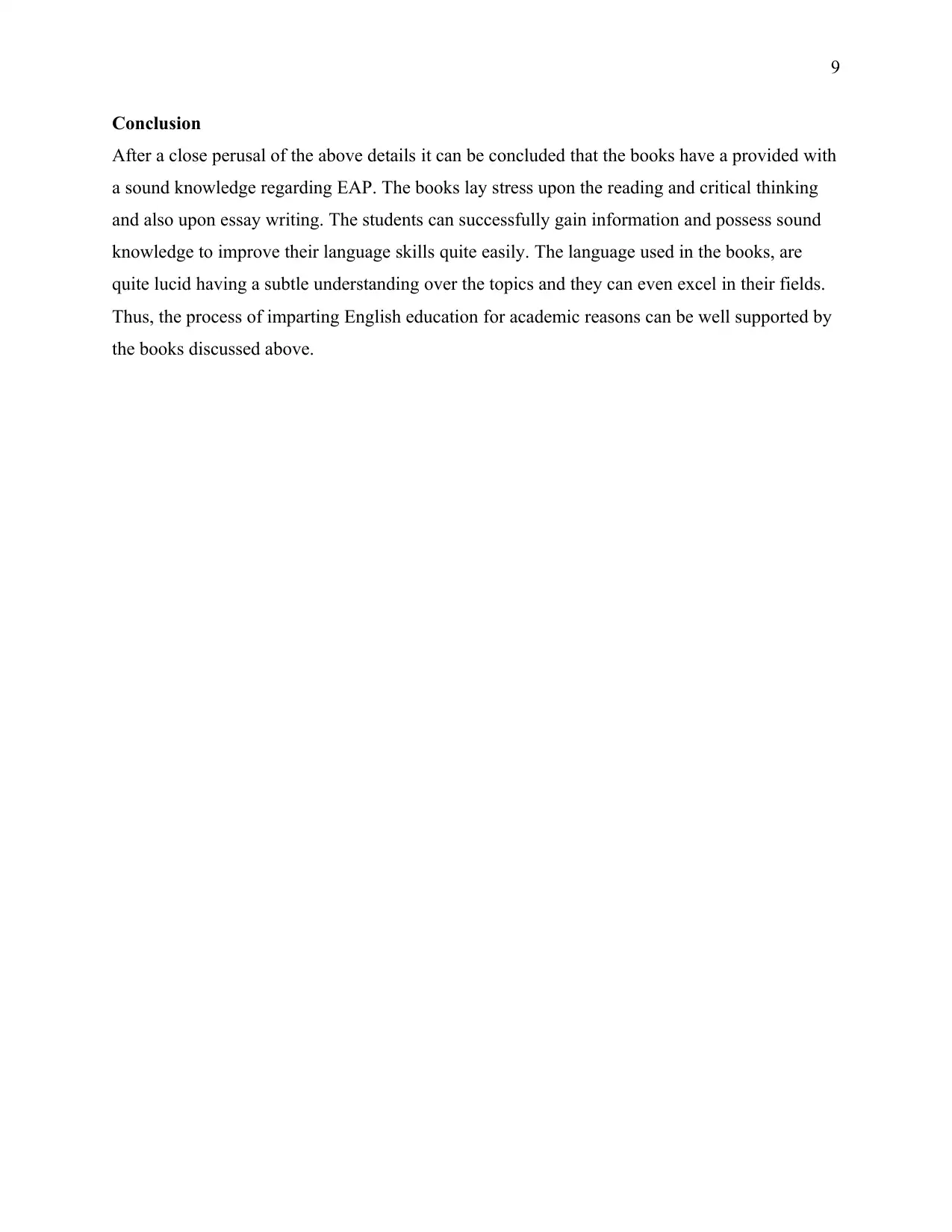
9
Conclusion
After a close perusal of the above details it can be concluded that the books have a provided with
a sound knowledge regarding EAP. The books lay stress upon the reading and critical thinking
and also upon essay writing. The students can successfully gain information and possess sound
knowledge to improve their language skills quite easily. The language used in the books, are
quite lucid having a subtle understanding over the topics and they can even excel in their fields.
Thus, the process of imparting English education for academic reasons can be well supported by
the books discussed above.
Conclusion
After a close perusal of the above details it can be concluded that the books have a provided with
a sound knowledge regarding EAP. The books lay stress upon the reading and critical thinking
and also upon essay writing. The students can successfully gain information and possess sound
knowledge to improve their language skills quite easily. The language used in the books, are
quite lucid having a subtle understanding over the topics and they can even excel in their fields.
Thus, the process of imparting English education for academic reasons can be well supported by
the books discussed above.
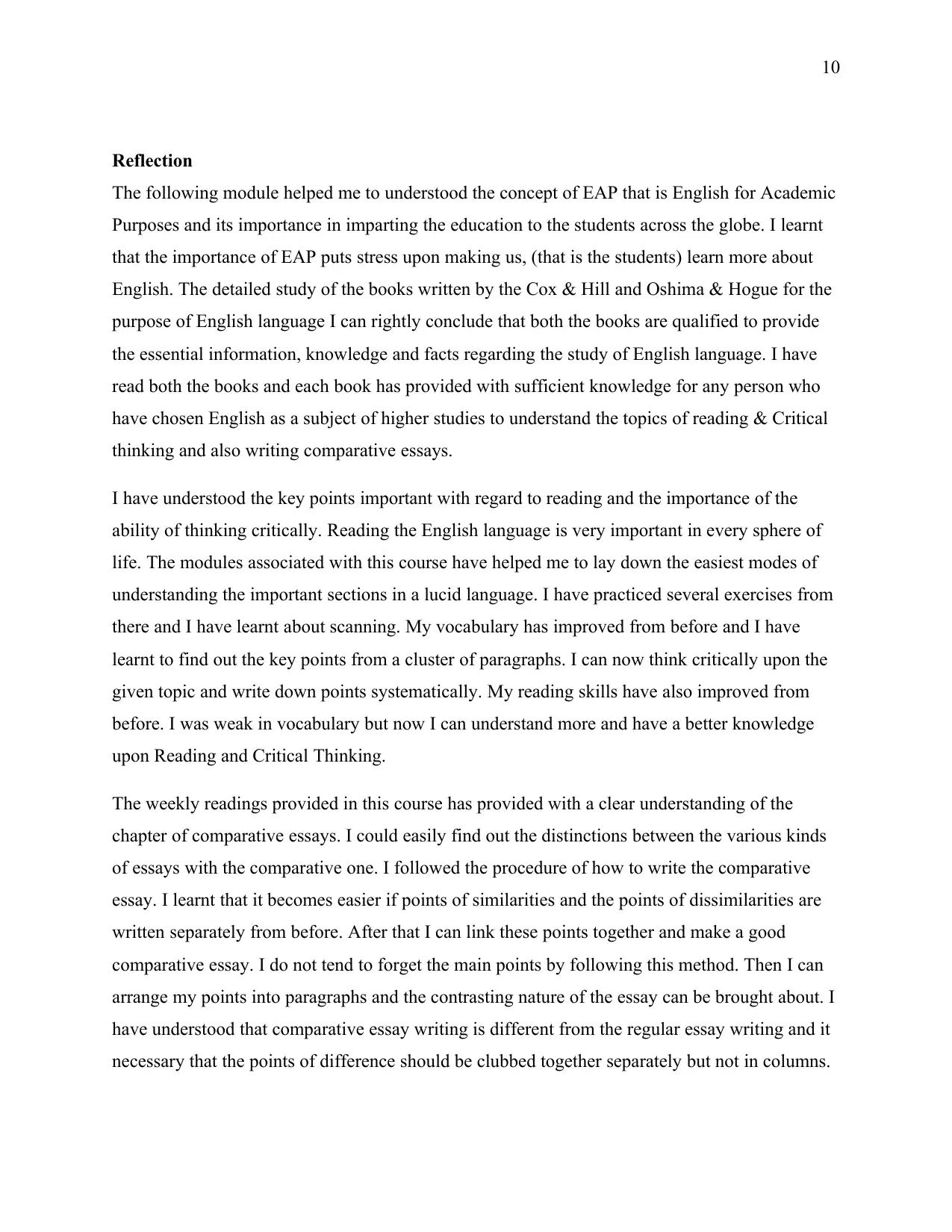
10
Reflection
The following module helped me to understood the concept of EAP that is English for Academic
Purposes and its importance in imparting the education to the students across the globe. I learnt
that the importance of EAP puts stress upon making us, (that is the students) learn more about
English. The detailed study of the books written by the Cox & Hill and Oshima & Hogue for the
purpose of English language I can rightly conclude that both the books are qualified to provide
the essential information, knowledge and facts regarding the study of English language. I have
read both the books and each book has provided with sufficient knowledge for any person who
have chosen English as a subject of higher studies to understand the topics of reading & Critical
thinking and also writing comparative essays.
I have understood the key points important with regard to reading and the importance of the
ability of thinking critically. Reading the English language is very important in every sphere of
life. The modules associated with this course have helped me to lay down the easiest modes of
understanding the important sections in a lucid language. I have practiced several exercises from
there and I have learnt about scanning. My vocabulary has improved from before and I have
learnt to find out the key points from a cluster of paragraphs. I can now think critically upon the
given topic and write down points systematically. My reading skills have also improved from
before. I was weak in vocabulary but now I can understand more and have a better knowledge
upon Reading and Critical Thinking.
The weekly readings provided in this course has provided with a clear understanding of the
chapter of comparative essays. I could easily find out the distinctions between the various kinds
of essays with the comparative one. I followed the procedure of how to write the comparative
essay. I learnt that it becomes easier if points of similarities and the points of dissimilarities are
written separately from before. After that I can link these points together and make a good
comparative essay. I do not tend to forget the main points by following this method. Then I can
arrange my points into paragraphs and the contrasting nature of the essay can be brought about. I
have understood that comparative essay writing is different from the regular essay writing and it
necessary that the points of difference should be clubbed together separately but not in columns.
Reflection
The following module helped me to understood the concept of EAP that is English for Academic
Purposes and its importance in imparting the education to the students across the globe. I learnt
that the importance of EAP puts stress upon making us, (that is the students) learn more about
English. The detailed study of the books written by the Cox & Hill and Oshima & Hogue for the
purpose of English language I can rightly conclude that both the books are qualified to provide
the essential information, knowledge and facts regarding the study of English language. I have
read both the books and each book has provided with sufficient knowledge for any person who
have chosen English as a subject of higher studies to understand the topics of reading & Critical
thinking and also writing comparative essays.
I have understood the key points important with regard to reading and the importance of the
ability of thinking critically. Reading the English language is very important in every sphere of
life. The modules associated with this course have helped me to lay down the easiest modes of
understanding the important sections in a lucid language. I have practiced several exercises from
there and I have learnt about scanning. My vocabulary has improved from before and I have
learnt to find out the key points from a cluster of paragraphs. I can now think critically upon the
given topic and write down points systematically. My reading skills have also improved from
before. I was weak in vocabulary but now I can understand more and have a better knowledge
upon Reading and Critical Thinking.
The weekly readings provided in this course has provided with a clear understanding of the
chapter of comparative essays. I could easily find out the distinctions between the various kinds
of essays with the comparative one. I followed the procedure of how to write the comparative
essay. I learnt that it becomes easier if points of similarities and the points of dissimilarities are
written separately from before. After that I can link these points together and make a good
comparative essay. I do not tend to forget the main points by following this method. Then I can
arrange my points into paragraphs and the contrasting nature of the essay can be brought about. I
have understood that comparative essay writing is different from the regular essay writing and it
necessary that the points of difference should be clubbed together separately but not in columns.
Secure Best Marks with AI Grader
Need help grading? Try our AI Grader for instant feedback on your assignments.
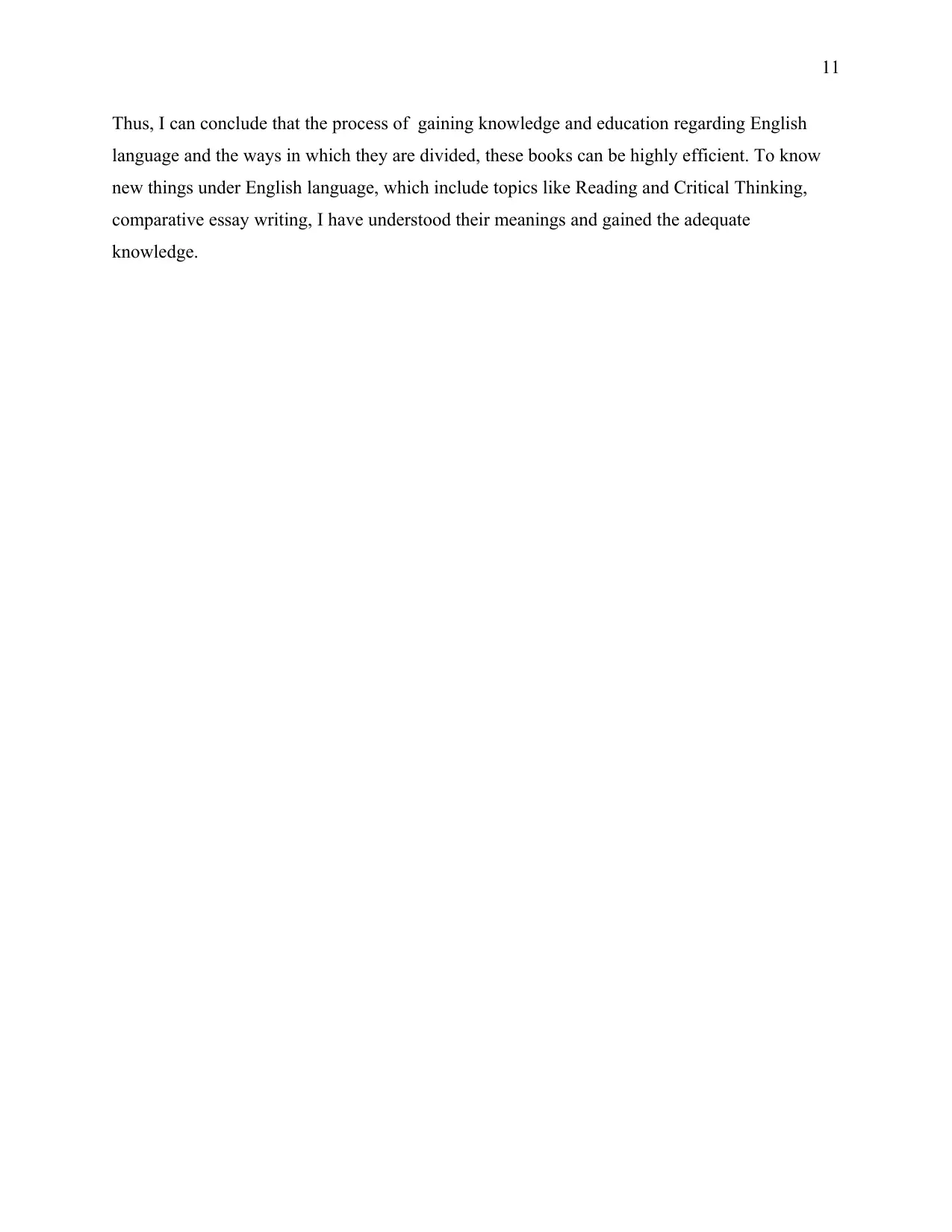
11
Thus, I can conclude that the process of gaining knowledge and education regarding English
language and the ways in which they are divided, these books can be highly efficient. To know
new things under English language, which include topics like Reading and Critical Thinking,
comparative essay writing, I have understood their meanings and gained the adequate
knowledge.
Thus, I can conclude that the process of gaining knowledge and education regarding English
language and the ways in which they are divided, these books can be highly efficient. To know
new things under English language, which include topics like Reading and Critical Thinking,
comparative essay writing, I have understood their meanings and gained the adequate
knowledge.
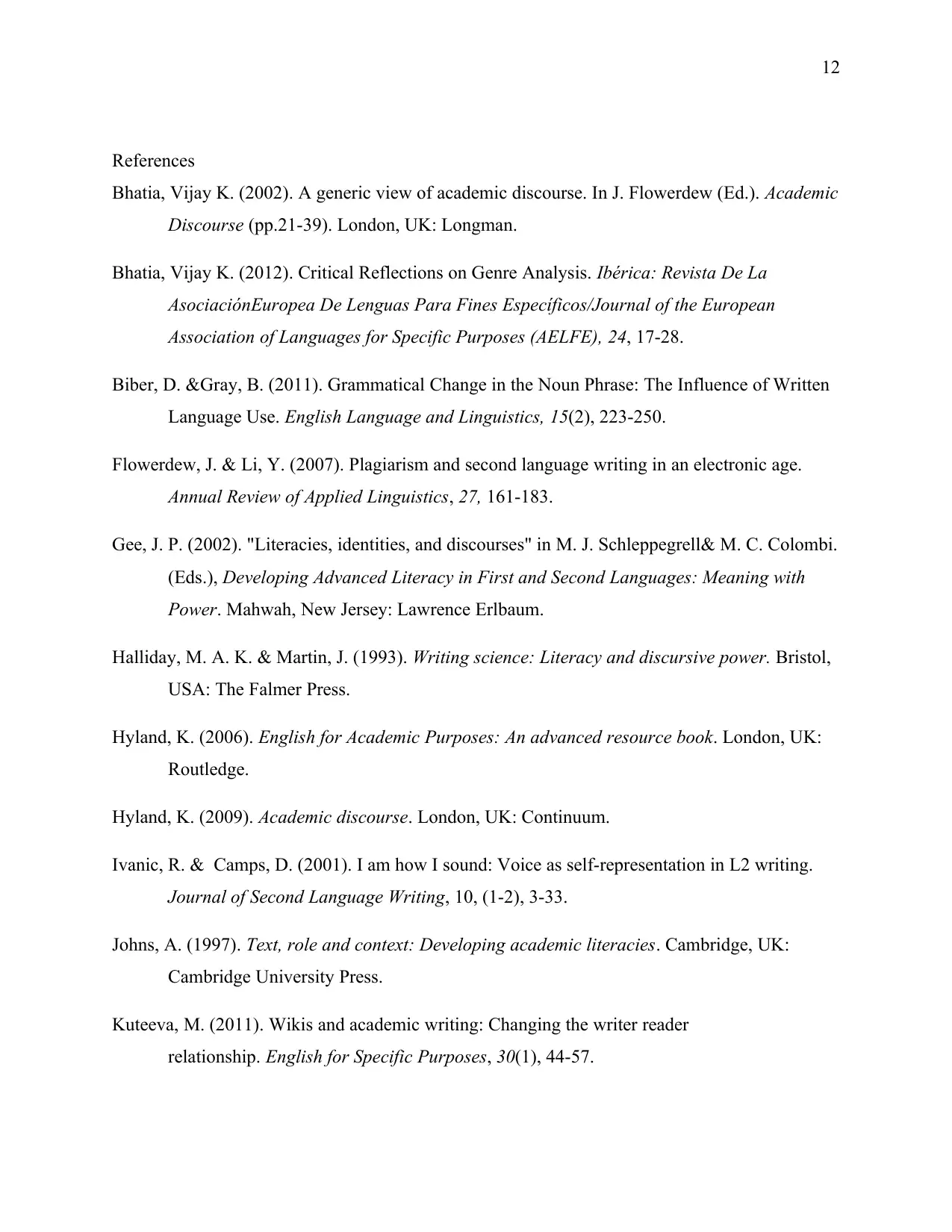
12
References
Bhatia, Vijay K. (2002). A generic view of academic discourse. In J. Flowerdew (Ed.). Academic
Discourse (pp.21-39). London, UK: Longman.
Bhatia, Vijay K. (2012). Critical Reflections on Genre Analysis. Ibérica: Revista De La
AsociaciónEuropea De Lenguas Para Fines Específicos/Journal of the European
Association of Languages for Specific Purposes (AELFE), 24, 17-28.
Biber, D. &Gray, B. (2011). Grammatical Change in the Noun Phrase: The Influence of Written
Language Use. English Language and Linguistics, 15(2), 223-250.
Flowerdew, J. & Li, Y. (2007). Plagiarism and second language writing in an electronic age.
Annual Review of Applied Linguistics, 27, 161-183.
Gee, J. P. (2002). "Literacies, identities, and discourses" in M. J. Schleppegrell& M. C. Colombi.
(Eds.), Developing Advanced Literacy in First and Second Languages: Meaning with
Power. Mahwah, New Jersey: Lawrence Erlbaum.
Halliday, M. A. K. & Martin, J. (1993). Writing science: Literacy and discursive power. Bristol,
USA: The Falmer Press.
Hyland, K. (2006). English for Academic Purposes: An advanced resource book. London, UK:
Routledge.
Hyland, K. (2009). Academic discourse. London, UK: Continuum.
Ivanic, R. & Camps, D. (2001). I am how I sound: Voice as self-representation in L2 writing.
Journal of Second Language Writing, 10, (1-2), 3-33.
Johns, A. (1997). Text, role and context: Developing academic literacies. Cambridge, UK:
Cambridge University Press.
Kuteeva, M. (2011). Wikis and academic writing: Changing the writer reader
relationship. English for Specific Purposes, 30(1), 44-57.
References
Bhatia, Vijay K. (2002). A generic view of academic discourse. In J. Flowerdew (Ed.). Academic
Discourse (pp.21-39). London, UK: Longman.
Bhatia, Vijay K. (2012). Critical Reflections on Genre Analysis. Ibérica: Revista De La
AsociaciónEuropea De Lenguas Para Fines Específicos/Journal of the European
Association of Languages for Specific Purposes (AELFE), 24, 17-28.
Biber, D. &Gray, B. (2011). Grammatical Change in the Noun Phrase: The Influence of Written
Language Use. English Language and Linguistics, 15(2), 223-250.
Flowerdew, J. & Li, Y. (2007). Plagiarism and second language writing in an electronic age.
Annual Review of Applied Linguistics, 27, 161-183.
Gee, J. P. (2002). "Literacies, identities, and discourses" in M. J. Schleppegrell& M. C. Colombi.
(Eds.), Developing Advanced Literacy in First and Second Languages: Meaning with
Power. Mahwah, New Jersey: Lawrence Erlbaum.
Halliday, M. A. K. & Martin, J. (1993). Writing science: Literacy and discursive power. Bristol,
USA: The Falmer Press.
Hyland, K. (2006). English for Academic Purposes: An advanced resource book. London, UK:
Routledge.
Hyland, K. (2009). Academic discourse. London, UK: Continuum.
Ivanic, R. & Camps, D. (2001). I am how I sound: Voice as self-representation in L2 writing.
Journal of Second Language Writing, 10, (1-2), 3-33.
Johns, A. (1997). Text, role and context: Developing academic literacies. Cambridge, UK:
Cambridge University Press.
Kuteeva, M. (2011). Wikis and academic writing: Changing the writer reader
relationship. English for Specific Purposes, 30(1), 44-57.
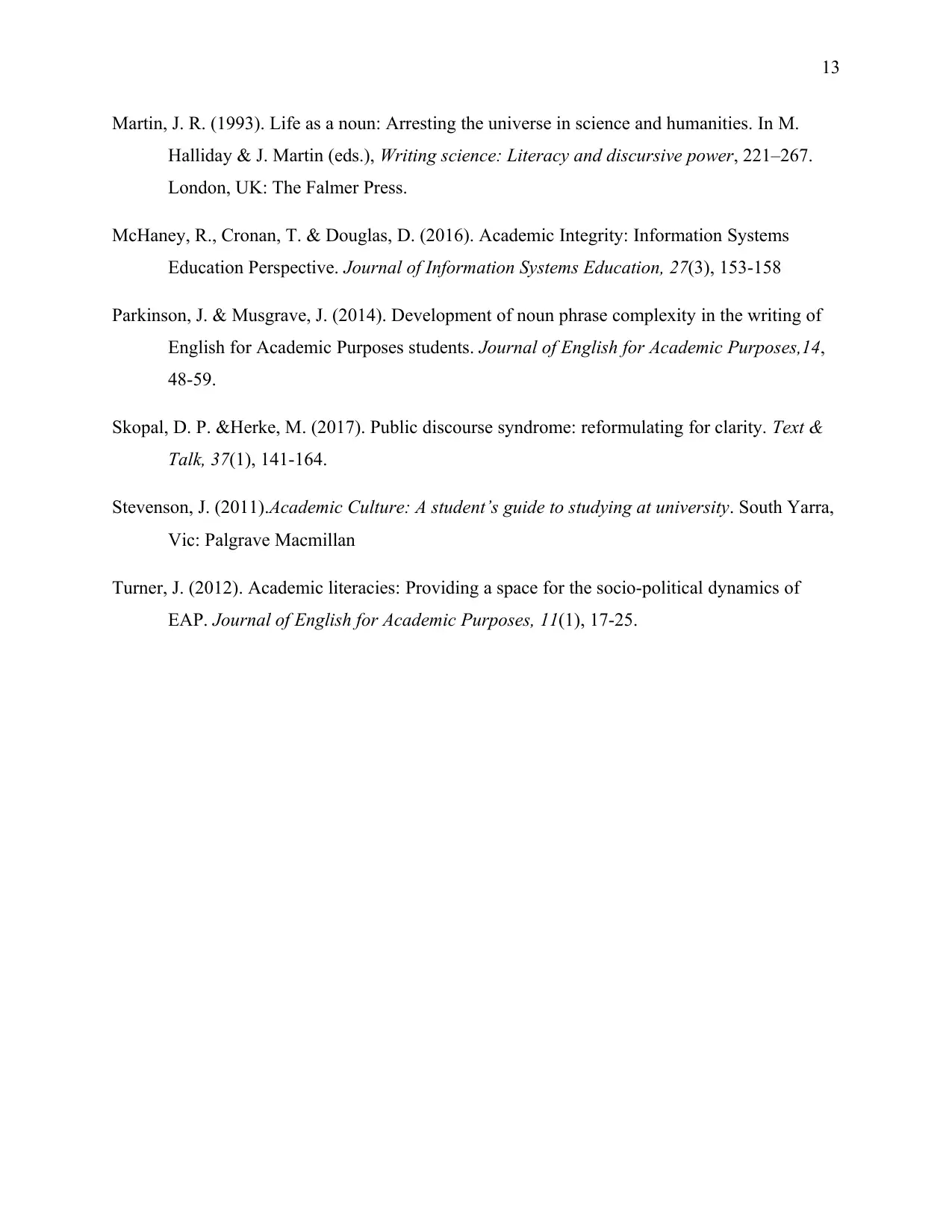
13
Martin, J. R. (1993). Life as a noun: Arresting the universe in science and humanities. In M.
Halliday & J. Martin (eds.), Writing science: Literacy and discursive power, 221–267.
London, UK: The Falmer Press.
McHaney, R., Cronan, T. & Douglas, D. (2016). Academic Integrity: Information Systems
Education Perspective. Journal of Information Systems Education, 27(3), 153-158
Parkinson, J. & Musgrave, J. (2014). Development of noun phrase complexity in the writing of
English for Academic Purposes students. Journal of English for Academic Purposes,14,
48-59.
Skopal, D. P. &Herke, M. (2017). Public discourse syndrome: reformulating for clarity. Text &
Talk, 37(1), 141-164.
Stevenson, J. (2011).Academic Culture: A student’s guide to studying at university. South Yarra,
Vic: Palgrave Macmillan
Turner, J. (2012). Academic literacies: Providing a space for the socio-political dynamics of
EAP. Journal of English for Academic Purposes, 11(1), 17-25.
Martin, J. R. (1993). Life as a noun: Arresting the universe in science and humanities. In M.
Halliday & J. Martin (eds.), Writing science: Literacy and discursive power, 221–267.
London, UK: The Falmer Press.
McHaney, R., Cronan, T. & Douglas, D. (2016). Academic Integrity: Information Systems
Education Perspective. Journal of Information Systems Education, 27(3), 153-158
Parkinson, J. & Musgrave, J. (2014). Development of noun phrase complexity in the writing of
English for Academic Purposes students. Journal of English for Academic Purposes,14,
48-59.
Skopal, D. P. &Herke, M. (2017). Public discourse syndrome: reformulating for clarity. Text &
Talk, 37(1), 141-164.
Stevenson, J. (2011).Academic Culture: A student’s guide to studying at university. South Yarra,
Vic: Palgrave Macmillan
Turner, J. (2012). Academic literacies: Providing a space for the socio-political dynamics of
EAP. Journal of English for Academic Purposes, 11(1), 17-25.
1 out of 13
Related Documents
Your All-in-One AI-Powered Toolkit for Academic Success.
+13062052269
info@desklib.com
Available 24*7 on WhatsApp / Email
![[object Object]](/_next/static/media/star-bottom.7253800d.svg)
Unlock your academic potential
© 2024 | Zucol Services PVT LTD | All rights reserved.





